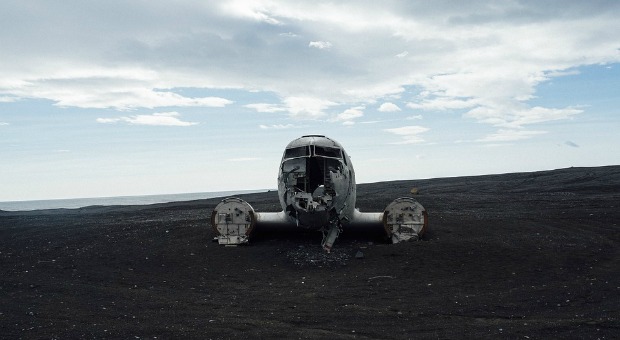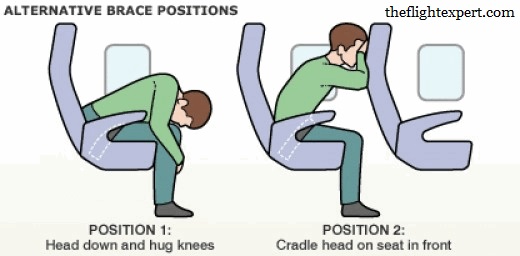Usually speaking, the general public believes that the vast majority of plane crashes leaves no one left behind alive to tell the story.
However, there are many exceptions to that rule. If we’re talking about science, well, there’s a whole science behind the concept of surviving a plane crash.
Actually, plane crashes are incredibly rare.
Statistically speaking, you’re more prone to dying while driving your car, i.e. in a car crash, than to be involved in a plane crash. Airplane-related incidents are a very rare occurrence and today they are at an all time low, due to the huge advances in flight security and technology.
What Are the Odds?
To give you a scientific example using statistics, the odds of the average Survivopedia reader being killed in a plane crash even providing that he/she flies regularly are 1 in 8015. The chances of any single flight being plagued by an incident are 1 in 1.2 million. The chance of you getting killed in a plane crash are over your entire lifetime 1 in 8015.
To put things into a broader perspective, your chances of being killed in a car accident are anywhere between 1 in 112 (over your entire lifetime) or anywhere between 1 in 4000/8000 every time you’re on the road, as there are many variables to take into account: what kind of vehicle you drive, how often and far you drive on a daily basis etc.
However, if you compare these aforementioned figures to the odds of dying in an airplane crash, you’ll have a hard time comprehending people’s fear of flying, or, for that matter, our utter nonchalance when it comes to driving for the most meaningless of purposes, but let that one go.
It’s also interesting to mention than a whopping 96% of all victims involved in an airplane crash survive. If that figure sounds very high, well, it’s because the vast majority of airplane crashes are not as catastrophic as one may be inclined to think watching TV all day.
Catastrophic airplane crashes, where the plane just drops out of the sky for some reason, aren’t typically survivable (except from blind luck), but they’re very rare. “Regular” plane crashes are totally survivable provided you don’t lose your head and you learn some tiny bits of essential information.
To make things real simple, an airplane is basically a long, combustible aluminum tube filled with people; go figure it out for yourself what happens in a crash landing, which defines the vast majority of airplane accidents nowadays (80% of plane crashes happen during take-off/landing procedures).
But modern-day airplanes are specially designed for allowing all of the passengers to be evacuated in 90 seconds tops, and that’s important because most of the injuries/victims when it comes to plane crashes are due to fires.
One thing that really grinds my gears is that almost ninety percent of the passengers fail to read the safety cards and half of them don’t watch the pre-flight safety presentations, even if the information regarding flight safety is a matter of life and death.
Simply put, actions have consequences and every action you take prior, during, and after a plane crash plays a vital role with regard to your chances of survival. To begin with, according to flight security experts, almost 33% of all casualties due to plane crashes in the past could have been prevented, provided the passengers had known their survival basics, i.e. what to do during and after the plane crash.
Choose Your Airplane Seat Carefully
Lesson number one: everything in life is about location, hence choose your airplane seat carefully, as per the picture below:
However, let’s be honest about it: surviving an airplane crash is not an exact science. Even if you choose your seat as per the illustration above, which, according to statistics, shows you the safest position inside of an airplane for surviving a crash, there’s no guarantee you’ll make it out alive if SHTF.
The thing is, even if certain seats are safer than others using probabilities, it all depends on the nature of a particular incident, i.e. if you sit in the front of the plane in the business class and the impacts occurs primarily in the rear, your chances of survival will be higher in this situation, right?
Still, the FAA claims that there’s no such thing as a safe space inside of an airplane, because there is no seat that’s safer than another. Airplane manufacturers are saying the same thing, arguing that all seats are created equal, provided you’re using the seat belt.
But, recent studies analyzing survival patterns of many catastrophic airplane crashes suggest that the rear third of the plane is the safest with regard to one’s chances of surviving, with the last row being the ideal spot due to its proximity to the rear exit.
Speaking of emergency exits, there’s always the five-row rule, which states that your chances of surviving a plane crash are pretty good if your seat is within 5 rows of an emergency exit. This theory makes perfect sense: the sooner you get out of the plane, the better.
The least safe seats in coach are in the middle third of the airplane and the same goes for seats located in the very front of the entire cabin (business/first class). The fatality rate of those passengers having to travel more than 5 rows to an emergency exit is significantly higher, so remember that next time you book a seat.
Overall, the lesson to be taken home is that middle seats in the rear third of the cabin are the sweet spots for surviving a plane crash.
Wear Flame-resistant Clothes
The next thing to contemplate is your clothing. Yes, you read that right because the biggest danger in an airplane crash, provided you survived the impact, is the combustible parts of the plane igniting and provoking a huge fire; therefore, your clothes are the first and last line of defense.
While there are flame-resistant clothes on the market, it’s not always possible to wear these, especially during business trips and all that. However, remember to avoid nylon, polyester and acrylic , as these materials are very dangerous in a fire because they melt (and burn) at relatively low temperatures, compared to other materials. That means that they will stick to your skin if heated enough, provoking horrible injuries as they burn.
Wool and cotton are way better and remember: do not wear skirts, dresses, shorts or flowing/loose fitting clothes during flight. Also, pay attention to your shoes. The best choice is to wear laced-up, comfy and sturdy leather shoes, made with solid soles and good traction. As you’ll be trying to escape from a burning plane, these details are very important.
Learn How to Operate the Safety Equipment
Always pay attention to the back seat pocket card and the safety presentation, as every aircraft model has its own safety procedures and features.
Learn how to operate the safety equipment and know where the emergency exits are, how to open them, and so on and so forth.
Know the +3 / -8 Rule
While it’s recommended that you stay alert and aware at all times, not only during flight, when it comes to surviving a plane crash, there’s the +3/-8 rule. This rule refers to the fact that most airplane crashes (80%) take place in the first three minutes after take-off and in the final 8 minutes of the flight.
During these periods of time, don’t read, don’t get distracted, and stay alert and ready to execute your plan if necessary.
Buckle Up for Safety
Seat belts are a no-brainer; always remember to buckle up for safety both while driving and flying. What’s crucial to remember with regard to airplane seat belts is that they’re somewhat different from their car brethren and it was widely reported that many passengers have difficulty and lose valuable time trying to remove their seat belts in the aftermath of a plane crash.
The thing is, unlike a car seat belt which releases at a push of a button, an airplane seat belt uses a different mechanism so you should familiarize yourself with removing your seat belt by both sight and touch, so you’ll be ready and able to release it instantly if SHTF even if the cabin is dark.
Also, remember to fasten your seat belt as tight as you can, as any loose inch matters in the eventuality of a high-speed crash. Every half inch of slack will triple the G-force you’ll have to endure in a crash.
Even if it may sound uncomfortable, I would advise you to keep your seat beat fastened even when you’re sleeping, especially when you’re sleeping.
Be Ready to Act
Now, with prevention taken care of, the “good news” so to speak is that you’ll probably be aware of the imminence of a plane crash long before it actually happens. That’s why it’s important to develop a plan, thus to dramatically increase your chance of surviving a plane crash just by taking a few minutes to think about what you’ll have to do to survive in the eventuality of an accident.
Be ready to act quickly, calmly, and efficiently in any crisis situation. Know where the emergency exits are located and count the rows to the nearest exit both behind and in front of your seat so you can navigate the cabin easily even in the dark.
Before the Crash
If the plane will have to perform an emergency landing over water, put your life vest on, but don’t inflate it until you’re out of the plane—this is important. An inflated life vest will impair your movements, making it harder to get out of the plane quickly.
Try to pad your head prior to impact, if possible, using pillows, a coat or blankets. Also try to protect your ankles and shins if possible and secure any loose items near you.
Empirical evidence teaches us that bracing for impact, i.e. assuming the proper position prior to a heavy impact, will maximize your chances of survival. The crash position is taught in the pre flight safety presentation and not only increases your chances of survival, but it also minimizes the risk of getting injured (neck, head, leg injuries) if you do actually survive the crash.
As soon as the oxygen mask drops, put it on. In the eventuality the cabin becomes depressurized, you’ll only have fifteen to twenty seconds to put it on before your rendered unconscious. Put your oxygen mask on before assisting other passengers or even your children. If you pass out, you’ll not be able to help anyone anyway.
After the Crash
After the crash, try to get out of the plane ASAP. Pay attention to the cabin crew instructions, as they’re well trained to respond in the event of a plane crash. Follow their instructions and remember—the first 90 seconds after a plane crash are essential, i.e. after 90 seconds, if you’re still inside the cabin, your chances of survival will drop dramatically.
Get out as fast as you can and as far away as you can – think kerosene exploding in a huge fireball.
Forget about your luggage, valuables, Mac Book, engagement ring or whatever. It’s not worth losing your life over stuff.
Don’t try to climb seats unless there’s no other way out. I must repeat, even if speed is essential after a plane crash, stay calm and try not to panic.
Don’t be stunned by the horrific events, move as fast as you can, and don’t lose your head. Most fatalities following a plane crash are due to fire and its derivates, i.e. smoke inhalation and fumes.
If there are smoke and fumes inside the cabin, lay low (don’t crawl though, stay on 2 feet) while evacuating and try to cover your nose and mouth using a piece of cloth (moistened would be ideal). You can also consider carrying a heat-resistant portable smoke hood.
Proceed to the nearest safe exit and move away from the crash scene, at least 500 feet away in an upwind direction. Then, assess the situation, take care of your wounds and/or assist others using basic first aid methods if you can. Stay close to the scene and wait for the rescue to arrive.
Will you be able to protect your own in a life or death scenario? Click the banner below to find out!










Farmer T | May 28, 2017
|
I would avoid the smoke hood. Nothing screams terrorist like having a piece of equipment “in case of an emergency or accident” as accidents can be made to happen. Being in the aviation industry I would agree with most of what Chris has said, good article. The most important thing is to indeed stay calm, exit as quickly as possible, and help others ONLY once you are taken care of. As Chris said, if you’re incapacitated, you can’t help anyone including yourself.
Don | May 29, 2017
|
There’s one more safety factor, that is never get on a plane in the first place! Although statistics say it safer to travel by plane than by car. They say the chances of a fatal accident is about a 7 to 1 chance of getting a safe ride in a plane over a car, maybe even a better chance in a plane. How many people were killed in car accidents last year as opposed to those in a plane! I doubt the comparison is even close. However, your chances of survival are better in a car than in a plane! So either way, it a chance of getting to a certain destination safely! HAVE A SAFE AND WONDERFUL MEMORIAL DAY TODAY! THANK YOU ALL WHO SERVED OUR COUNTRY IN ALL THE PAST WARS SO WE COULD HAVE WONDERFUL DAYS LIKE TODAY! GOD BLESS YOU VETERANS!
Pingback:How To Survive A Train Accident | Survivopedia | June 26, 2017
|
TruthB Told | March 17, 2020
|
You beat me to it. The point about the odds of “surviving “a car crash compared to “surviving” a plane crash is never brought up. It’s always the odds of “being in one”. Another point, in a fatal plane crash you will usually have many minutes (up to an hour) to think about your impending death.
Deborah | March 18, 2019
|
May I add – Wear good shoes. Not cute sandals or flip flops. I have always told m daughter that her feet will carry her out so make sure they are protected. Personally I think good sturdy leather shoes or boots. Not something that melts easily from heat or fuel and no high heels. Something you can run for your life in!
Bob L. | May 19, 2019
|
“Buckle up for safety” is a good idea throughout a flight. When I used to travel by air, I would just loosen the belt some during the flight. Clear air turbulence gives little or no warning and I had no desire to kiss the ceiling and then crash down on someone else.
Chris Connolly | October 11, 2019
|
Excellent advice. As a veteran and frequent flyer on terrible aircraft in third world nations I can attest to the value of this information. Adhere to this advice and you and your family will have a much better chance of surviving.
The extra piece I would commend us all to consider is to carry an EPIRB and water purification straw on long-haul flights (eg: US to Oz) in a fanny pack placed in the pouch on the back of the seat in front of you. As the author said, don’t waste precious time fumbling with luggage. Get your life vest on, grab that fanny pack in front of you. Get out ASAP. Great article. Stay safe friends.
Elaine | November 27, 2019
|
The Chart with Fatal Airline Crashes: Is this based solely on numbers? Or is it on percentages? While the US might have way more crashes than other countries, is this only because we have more airports and flights and passengers than other countries, so of course we would have a higher number? And why are certain countries not listed? Is it because they have had zero crashes? I mean, take China for instance. They have the highest population of any country. So did they have zero crashes (which would be great)? Or were the creators of the chart unable to get data from China? Really good suggestion to not where plastic clothes! Much harder to find natural material clothing, but great idea! Try to have some to use for flying at least! Great article!
Debee Boulanger | November 27, 2019
|
Thanks Chris! I knew about a few things already however you pointed out some plane game changers!
TruthB Told | November 28, 2019
|
The only sure way to survive an airline crash is to not fly.
Travelin On | March 14, 2022
|
AMEN!!! Retired from the aviation industry there are no words strong enough to state why I never plan to get on an aircraft again.
Todd Mellema | August 25, 2020
|
After the crash. Stay at the crash site. No matter where in the world you crash (unless in water or in hostile circumstances ) your best chance of survival is to stay in proximity to the crash site. After you access the situation, nothing attracts attention like smoke. Once the crash quits burning naturally there is usually something to burn to attract attention of rescue services. Tires are a good source for black smoke just deflate them first. Don’t burn items unnecessarily for you are wasting resources. SAR crews normally are ambitious in the morning and ambition wanes as the day or days ware on. Post sentries early to watch or listen for aircraft and light rescue fires only when necessary. The crash site generally will provide materials to build shelter and scrounging the site will generally produce other items needed for survival. Treat the wounded, build shelter, organize resources and wait it out.